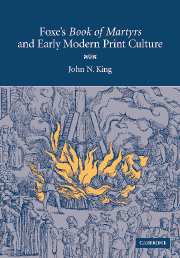Book contents
- Frontmatter
- Contents
- List of illustrations
- Acknowledgments
- List of abbreviations
- Note on texts
- Introduction
- 1 The compilation of the book
- 2 The Books of Martyrs in the printing house
- 3 Viewing the pictures
- 4 Reading the pages
- Glossary of printing terms of the hand-press era
- Select bibliography
- Index
- References
Select bibliography
Published online by Cambridge University Press: 22 September 2009
- Frontmatter
- Contents
- List of illustrations
- Acknowledgments
- List of abbreviations
- Note on texts
- Introduction
- 1 The compilation of the book
- 2 The Books of Martyrs in the printing house
- 3 Viewing the pictures
- 4 Reading the pages
- Glossary of printing terms of the hand-press era
- Select bibliography
- Index
- References
- Type
- Chapter
- Information
- Foxe's 'Book of Martyrs' and Early Modern Print Culture , pp. 325 - 340Publisher: Cambridge University PressPrint publication year: 2006



